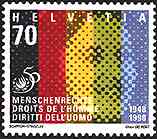In the
"La Loupe", issued by the Swiss Postal Administration, October 1998 I found an
interesting article. Author: Christoph Pappa, Federal Department for Foreign Affairs,
Political Division IV, Bern. Text to the photography, reproduced above:
"The representatives who elaborated the Universal Declaration of Human Rights
from 1948. From left to right: P.J.Schmidt, Administration of UN; C.L.Hsia, China;
K.C.Neogi, India; Eleanor Roosevelt, USA; Henry Laugier, Assistant of the General
secretary, USA; Nicoli Kruikov, USSR and Dusan Brkish, Yugoslavia. April 29, 1946".
Translated from French by V.M.
The whole thing raises
several questions:
- Who actually wrote the first version of the
Declaration, the Canadian Mr. J.P. Humphrey, the representative of France Mr. René
Casin, the group from the photography or all of them, in successive steps?
- Why is it so difficult to establish, after
only 50 years, who has really elaborated it?
- What is there to think about a declaration of
Human Rights elaborated, among others, by the representatives of China, USSR and
Yugoslavia, countries that never respected them?
- And the last one, as extrapolation. If the UN,
with its about 150 members, would exclude those countries that don't respect the Universal
Declaration of Human Rights, how many of them would remain? My guess is: about a fifth of
them!
Another interesting
extract from the same article: "Today, it is a question of smaller importance to
know what the human rights are than to know how to make them be respected.". I wonder
how the author will make respected some rights without defining them firstly. It is like
establishing a police force and then seeing what its job is (what rights it must protect).
And last but not least,
a troubling coincidence. On October 25, 1998 the Swiss Postal Administration has
issued some new philatelic materials. The same day as the world has got a Swiss stamp
dedicated to the Universal Declaration of Human Rights (the first stamps
shown on this page), it has also discovered a
joint issue Switzerland - CHINA (2 stamps, a S/S, 2 MC, 2 FDCs, 4 special
flights!) shown above on the right. The
fact that a free country like Switzerland decided to issue a joint stamp with China (a
country that systematically infringes the Human Rights) is already
questionable.
To issue it the same day with the stamp dedicated to the Universal Declaration of Human
Rights is more than questionable indeed!
Addendum
In the November 1998 issue of the Schweizer
Briefmarken Zeitung (Swiss Stamps Magazine), the official publication of the Union of
Swiss Philatelic Associations, page 583, there is an article with the title: The Post
Communicates. The article, obviously written by someone representing the postal
administration, is dedicated to the joint issue Switzerland - China mentioned above.
Quote: "The legendary Bridge 24 serves as a joining element. This important building
was put in verses by many poets. Also the great Mao Tse-tung could not resist writing
a poem about this bridge". Look how an laudable attempt to establish bridges among
people is immediately used for propagandistic purposes, in our case for
giving us a positive
image (great Mao, oh such a poet!) of the biggest murderer in the history of mankind
(having on his conscience ten times
more victims than all people killed during the horrible Holocaust in Europe).
So much to the topic Human Rights.
This article was published on
10/9/98, in an adapted form, on the newsgroup 'rec.collecting.stamps. discuss'. The
addendum was added on 11/08/98.
Interested in this
subject? Then click here
to jump to a page containing a conversation with Mr. John Hobbins, the historian at McGill University thanks to whom the true role
of Mr. Humphrey was (re)discovered and internationally recognized.
Mr. Hobbins is the literary executor of John Peters Humphrey.
Please click the link
on the right to read
an article where its author compares the U.N.'s Declaration with the Bill of Rights and
the American Constitution.

|




